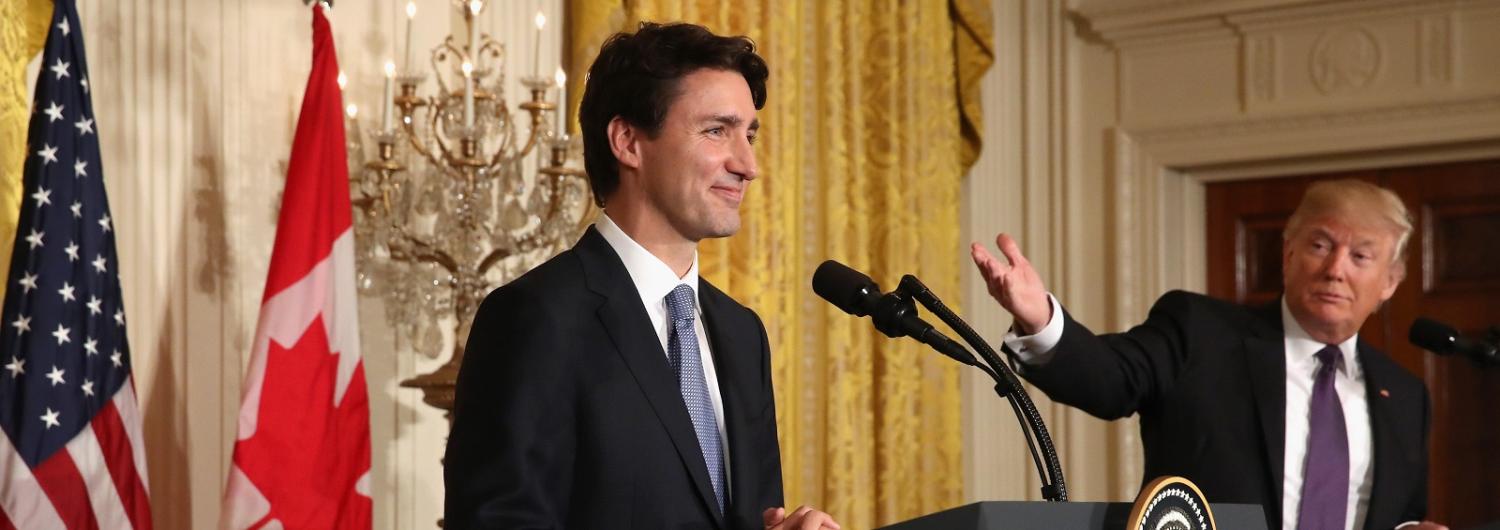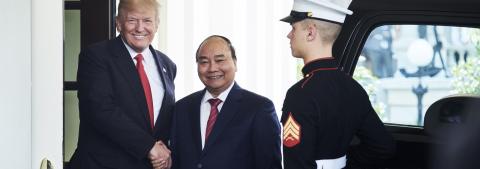Last week Canadian Prime Minister Justin Trudeau completed his first official visit with President Donald Trump in Washington D.C. Trudeau and his staff were no doubt aware that it’s usually the other way around: since the early 1980s, there's been an unofficial tradition that the first foreign visit by a new US president is to Canada.
Reagan addressed the Canadian parliament in March 1981. George H W Bush met with then Canadian Prime Minister Brian Mulroney in February 1989. Clinton went to Vancouver in April 1993. George W Bush deviated from the pattern, but he followed his first visit as president to Mexico in February 2001 with a trip to Quebec a month later. Obama went to Ottawa during February 2009.
Trump could still make his first trip to Ottawa. But it’s hard to see him choosing a city that boasts the world’s largest ice rink over another weekend at the 'Winter White House' in Florida.
The change in precedent marked by Trudeau's trip last week shows the extent to which the Canadians thought that a forward-leaning visit would count in this White House. And it seems to have paid off. The trip - and the events and strategy that preceded it - is an excellent case study for other countries looking for ways to navigate the new administration.
The Canadian approach suggests that, in Trumpland, personal connections are the way forward. But the outcomes also demonstrate that dealing with this administration comes at a cost.
Canada's major concern is Trump’s particular brand of economic nationalism. On the campaign trail, Trump repeatedly stated that he would renegotiate NAFTA, the free-trade agreement implemented in the 1990s that has governed North America’s economic relations for the last 20 years.
Plenty of politicians on both sides of the US-Canada border have lamented NAFTA at various times, often calling it 'unfair'. A multilateral renegotiation and updating of the Treaty, involving all three parties, was likely at some point. But a renegotiation under Trump, potentially involving the reimposition of tariffs, could be devastating for Canada’s economy and the nearly $2 billion in daily trade between the two countries.
Canada’s economy is almost entirely dependent on trade with its southern neighbour. Two-way trade between the two nations reached US$662.7 billion in 2015; 20% of Canada’s GDP comes from goods exported to the US. In 2014, US exports to Canada outweighed all American exports to China, Japan, South Korea and Singapore combined. If protectionist forces begin to mount in the US, Canada would be the first to feel the results.
Preparing for the new broom
It appears that shortly after Trump's victory in last year's presidential election, Trudeau began laying the groundwork for a cabinet reshuffle, one based on the new political landscape in the US.
Prior to the New Year, Trudeau’s principle secretary Gerald Butts, his chief of staff Katie Telford and Canada’s ambassador in Washington, David MacNaughton, convened in D.C. several times, meeting with key Trump advisors Jared Kushner and Steve Bannon. Interestingly Peter Navarro, who has helped shape much of Trump’s thinking on trade policy, was also part of those initial conversations.
Those discussions seem to have fed into a cabinet reshuffle that was announced in early January. The biggest move was the replacement of Stéphane Dion (a former Liberal Party leader) as minister of foreign affairs with Chrystia Freeland, a former journalist and minister of international trade. A former trade lawyer, François-Philippe Champagne, was named to the international trade portfolio and Ahmed Hussen, a lawyer and refugee advocate, was made the minister for immigration.
Freeland, a former journalist and Russian speaker, is seen as a pivotal choice because of her experience concluding the EU-Canada Comprehensive Economic and Trade Agreement late last year. She has also written a well-regarded book on plutocrats. To help her make connections with Trump’s military-heavy cabinet appointees, a former Canadian general, Andrew Leslie, was named her parliamentary secretary. Freeland’s former chief of staff was also transferred to the Prime Minister’s Office to head up the US desk.
Even prior to her promotion to foreign minister, Freeland was shaking hands in Washington, meeting with former House Speaker Newt Gringrich and the head of Trump’s Strategic and Policy Forum, Stephen Schwarzman.
Freeland looks to be a wise choice. In a meeting with Rex Tillerson shortly after his Senate confirmation, she smiled through an answer to a reporter’s question regarding Canada’s forthcoming negotiating position: 'Canada definitely will be and is good at taking strong offensive positions'.
This new cabinet met in Calgary for a strategy session shortly after Donald Trump’s inauguration. While the three-day summit was ostensibly to plan out the year’s legislative agenda, the new cabinet was building on the groundwork laid by Trudeau’s aides the previous year. Both Jared Kushner and Stephen Schwarzman made appearances at the closed-door summit.
These Calgary sessions seem to have resulted in an all-hands-on-deck approach towards the new administration. Trudeau recorded a video message that was played to Congress that emphasised the economic relationship between the two countries. Former Canadian Prime Minister Brian Mulroney, who helped negotiate NAFTA, was enlisted to open doors in D.C.
Mulroney even serenaded Trump and guests at Mar-a-Lago last weekend.
This preparatory work culminated in the visit by Trudeau last week. Canadian journalist and analyst Evan Solomon has laid out the three-pronged strategy that Trudeau employed with Trump to make all this groundwork stick.
The first was 'finding common ground'. Trudeau knew that the ideological gulf between himself and Trump likely only converged at one point: the middle class and jobs. The Canadian prime minister's speech focused on jobs, growth and infrastructure. Canada couldn’t offer an economic package like Japan’s Prime Minister Shinzo Abe could, but it does have leverage on infrastructure, a key component of Trump’s economic vision.
The second tactic was getting inside the Trump family circle. The multiple meetings with Jared Kushner seemed to be key here, and resulted in the Canadian suggestion to form the Ivanka Trump-led Canada-United States Council for Advancement of Women Entrepreneurs and Business Leaders. As Solomon has argued, this 'was a brilliant way for Trudeau to look as if he was, literally, inside the family circle'.
The knock-out seemed to be a shrewdly thought-out present to the new US president. Trudeau gave a photo of his father, Pierre Elliot Trudeau, with Trump at the Waldorf Astoria in New York in 1981. This was a smart play, reminding Trump of his New York days and of his old family connection with the Trudeaus.
The cost of success
Trudeau returned to Ottawa with the statement from the Trump administration that it only intended to 'tweak' NAFTA; a victory considering the very real possibility that a trade war and reimposition of tariffs was on the cards.
But this win came with costs.
One was the effective abandonment of the third member of NAFTA, Mexico, left to sort out its own separate negotiations with the US. For example, it’s clear Canada intends to negotiate a new agreement over dispute settlement mechanisms with the US that will then be presented to Mexico.
While the bilateral trade position between the US and Mexico is different to that between Canada and the US, Canada has allowed its larger trading partner to pick off each member of the trade agreement, where it will have considerable leverage. While Canada may think it has avoided the problems associated with the US-Mexican relationship, it will miss that added voice in the room when the real negotiations begin.
There is also a political cost. A large part of Trudeau’s political success has been his reinvigoration of Canadian values that seemed to have fallen away during the Harper years. When a right-wing terrorist targeted a mosque in Quebec, killing six, several days after Trump instituted his travel ban on seven, primarily-Muslim, countries, White House press secretary Sean Spicer used the Quebec attack to justify the executive order.
'It’s a terrible reminder of why we must remain vigilant, and why the president is taking steps to be proactive, rather than reactive, when it comes to our nation’s safety and security,' Spicer said.
The day before the Quebec shooting, Trudeau did tweet out a subtle rebuke to Trump’s immigration executive order, restating the values on which Trudeau was elected. But there was no official response to the Spicer comments.
For this silence, his fairly soft statement on immigration standing next to Trump, and participating in the women’s business council with a president who has some demonstrably sexist views, Trudeau was slammed domestically from the left. In the Canadian House of Commons, the immigration critic for the NDP Jenny Kwan said:
From Vietnam to Iraq, Canada has a proud history of standing up to the US on issues of principle… Now that he is back safe and sound on Canadian soil, will the Prime Minister summon the courage to denounce Trump’s immigration policies?
Even though by all accounts the visit was an economic success, the tempering of Trudeau’s core message shows the extent to which Trump’s election to the top office in the most powerful country in the world has forced others to bend to his rhetoric.

